
S/V Dalliance

Guadeloupe
Guadeloupe was known by the Caribs as Karukera or Island of Pretty waters. It has a population of about 300,000 people and is a part of France. French and Creole are the primary languages spoken and the Euro is the form of currency used. Guadeloupe is actually composed of two separate islands and form a shape that many consider to look like a lopsided butterfly. The western side is called Basse-Terre (low land) which is ironic since it is actually the mountainous region of Guadeloupe. The eastern section is called Grande Terre (large land) and is smaller than the western side. However named these islands probably also name Greenland and Iceland!! The two halves are separated by a river called Riviére Salée that some cruisers are able to go through when cruising north or south. Dalliance would not be making that trip since we draw 6 ft. and would be to shallow for her. So we decided to hit the Iles des Saintes first then head north along the western side of the butterfly called Basse-Terre.
Iles des Saintes
March 6-8, 2007

After having said goodbye to Ylva and Jonas, Marco and I left Dominica for the small group of islands south of Guadeloupe called Iles des Saintes. We headed for the island called Terre D'en Haut and anchored off the small town of Bourg des Saintes, in Saintes Harbor, the same anchorage that Admiral de Grasse's entire fleet anchored in. It was at the Saintes that Admiral Rodney dealt a decisive blow to the French navy, and established British naval supremacy thereafter. The Saintes have been occupied by the French since shortly after they were colonized. They have a strong link to northern France, especially Brittany, and you almost felt like we were in a tropical Brittany. The Saintes have mainly relied on fishing, since the land was not fit for agriculture, and therefore no slaves were ever imported.
The town of Bourg is adorable with red roofed homes and shops painted in fun bright colors. The only downside is that there are many ferries that bring tourists over from the mainland and the town turns into a tourist trap during the day.
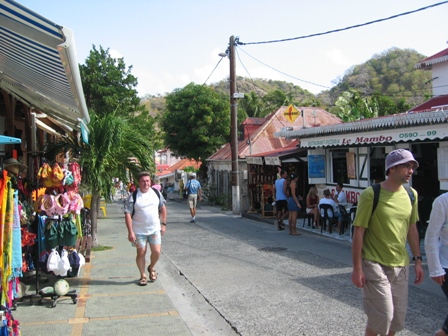
The town of Bourg.
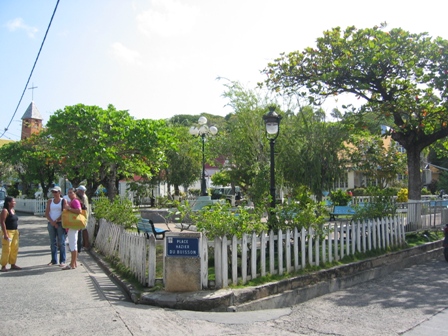
The main square in town.
There were plenty of things to keep us busy though so we decided to rent a moped to get out of town during the day and see the rest of the island.
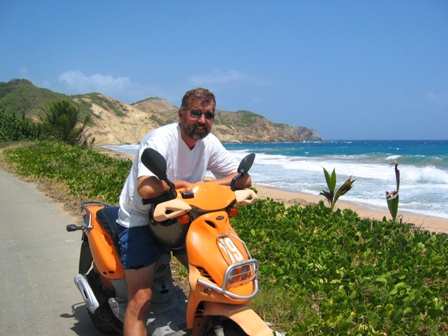
Our first stop on the tour was to Fort Napoleon, built in 1867 that stands on a hill overlooking town. The whole top half of the fort has been turned into a botanical garden of cactus and succulents. Succulents, ( ie: Aloe, Euphirbia), are plants with fleshy leaves and contain large quantities of water.
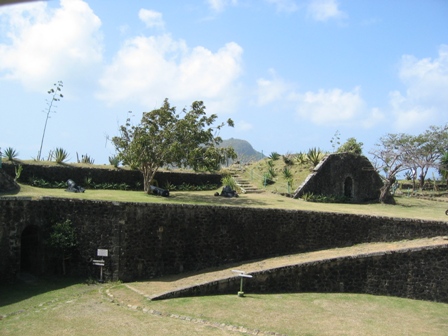
On top of the fort with the botanical gardens surrounding it.
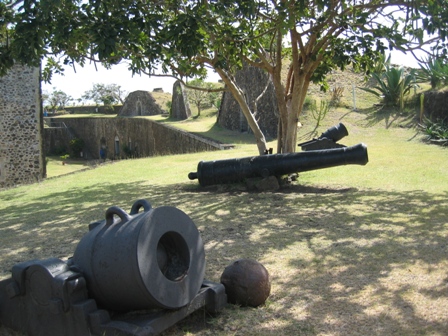
These 3 guns, an English sea-mortar with short inner tube, made in Carron (Scotland) in 1805. It was used to fire explosive cannon balls. The second cannon is an 18 lb cannon made of cast iron and was made in 1793 and inscribed with, "Liberté-Egalité. It was made in Le Creusot (France). It measures 2.60 m. (8 ft.) and weighs 4,000 lbs. The last on pictured is a small calibre sea-mortar.

All over the forts gardens we found these iguanas. These reptiles are completely harmless and are protected by a "Departmental decree" signed in 1975. The lifespan of the iguana is between 10-12 years. Having freed itself from an aquatic life thousands of years ago, to this day it still is an excellent swimmer and diver. These iguanas now live in the trees and shrubs and eat the leaves, flowers and fruits of the garden. Its color varies according to age, and sex: green for the young, a brown/green for the male and grayish for the female. The female lays about 20 eggs once a year and can measure up to 1.50 m (about 5 feet).
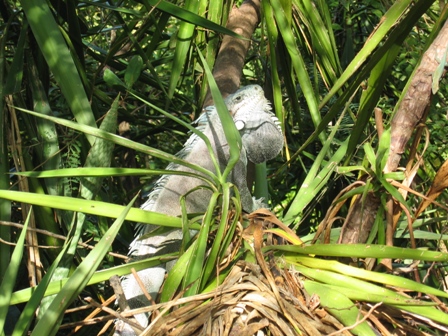
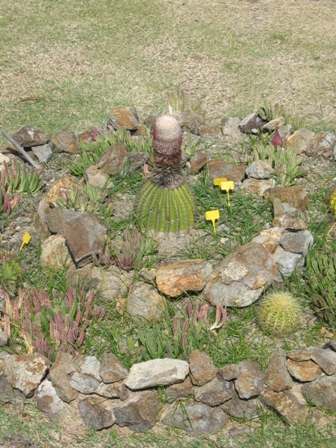
This is also another protected species in the garden. It is Melocacti also known as "Pope's Head" or like the French like to call them, "English Heads". The name dates back from the time French soldiers used the cacti on the surrounding hills as target practice, pretending they were the English enemy. When Melocacti are fully grown, the plants first develops a purple berry which in turn becomes covered with a "wooly" bonnet of red/brown hair called the Cephalium. The Melocactus is a threatened species and has been protected on Terre de Haut since 1989.
Inside the fort was a wonderful museum that told a lot about the Battle of de Saintes and also had contemporary art.

Ville de Paris
90 gun ship of the Line
Ville de paris was built in 1757 in Rothefort, France, by the naval architect Clairin Deslauriers. Originally named L'Impétueux, the name was changed when the town of Paris took over the cost of building the ship. A shortage of timber delayed the launching of Ville de Paris until 1764. The hull of a first rank vessel could be up to one meter thick and was made of solid oak. It took up to 2000 oak trees to build a ship of this type.
During a refit in 1778/1779, 10 cannons were added and 4 more were added again 1780. Ville de Paris became a 104-gun ship but looked no different to any other 3-decker. Ville de Paris was the flagship of Admiral de Grasse at the Battle of the Saintes in 1782. Captured by the English, Ville de Paris sank in the Atlantic as she was being towed into England.
After touring Fort Napoleon Marco and I got back on the moped and continued on. The roads were narrow but fairly maintained. The only things that you had to keep out in terms of road hazards was the livestock in the streets.
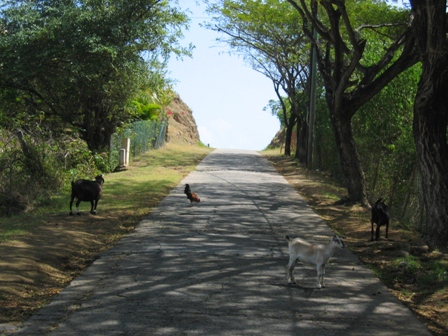
Chickens and goats blocking the road.
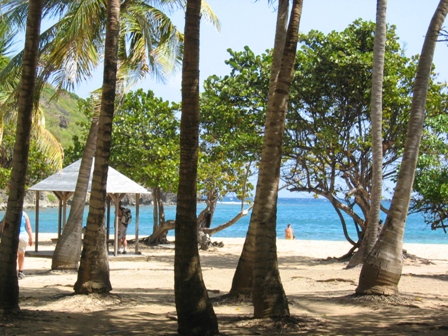
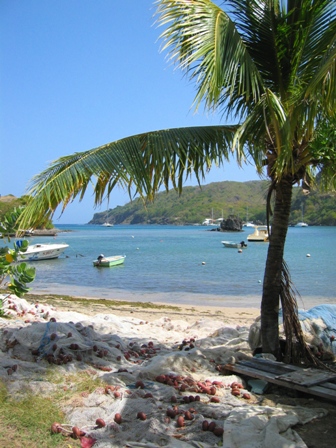
Different beaches and bays around the island of Terre D'en Haut.

The bay called Anse Á Cointre where we ended the day and snorkled around the northern tip called Pain de Sucre.

Pain de Sucre (Sugar loaf).
Ilets Pigeon, Basse-Terre, Réserve Cousteau
March 8-10th, 2007

Jacques-Yves Cousteau (1910-1997)
After taking in the sights of Ilse de Saintes Marco and I picked up anchor once again this time heading for mainland Guadeloupe to Ilets Pigeon. Here at Ilets Pigeon, Cousteau discovered what he considered to be one of the best dive sites in the world. In recognition of Cousteau, this area of 150 acres near the tiny islands of Malendure on the western coast of Basse-Terre, a submarine park was set up, called the Réserve Cousteau. The reason this dive site is so much more beautiful than other around it is that the hot volcanic springs around the islands have created a wonderful warm environment leading to a great diversity of sea life. The water temperature remains constant around 82° F and the visibility is still perfect in depths of 65-130 feet.

The movie poster from Le Monde du Silence
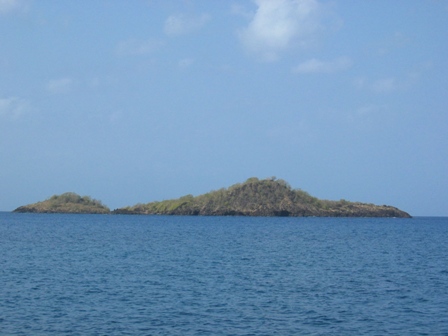
Pigeon Island is composed of volcanic stone and scrub trees. The area actually has two land masses, North Pigeon and South Pigeon.
On our first dive we chose to dive the North East Reef located on North Pigeon Island. It was an amazing wall that drops to 40ft. to a shelf, then gently slopes down to 70 ft. and finally plunges off to about 140 ft. Along the wall we saw it looked like a painting with lacy soft corals, huge tube sponges, plate corals and really large pillar-coral formations. We saw groupers, puffers, big French Angel fish and a really large barracuda. We ended up going as deep as 85ft. and without my depth meter it would of felt like only 20 ft., the visibility was that clear.
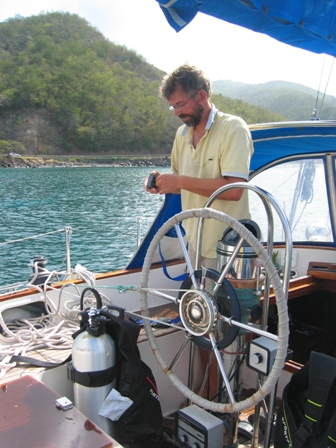
Marco had to change our weight belts, since we last dove in RI where we wore full 1/4 inch suits. Here we are only going to be wearing shorties. We both were very excited to get out and see the underwater world.
After emptying one set of tanks Marco and I got them refilled and headed out back again for a second dive for the day. It worked out really well just entering the water from our dinghy and then removing our BC's (bouncy compensators) with tanks before we got back into the dinghy after we completed the dive.
On our second dive we chose the North Side Reef. Here there were huge clusters of tube sponges, some of them over 6 ft. tall, with enormous purple and green sea fans waving in the gentle current, and there were huge boulders of brain coral everywhere. The reef began in shallow water and dropped off where there was a maze like structure of canyons in about 60 ft. of crystal clear water. Here we saw very large gray groupers, trumpet fish, angle fish, parrot fish, tropical flounder, hog fish and many other species. As we were suspended weightlessly and laying on our backs we watched "flocks" of fish swimming above us. It was truly an amazing experience, one we won't forget soon.
Anse Deshaies, Basse-Terre
March 10-12th, 2007
Deshaies (pronounced Day-hay) is a little fishing village near the northern tip of Guadeloupe's north coast. The bay was deep and well protected from the hills and mountains that surround it. While at anchor here it was not uncommon to see a large green sea turtle surfacing for a breath of air. We came here because we could go to customs to check out of the country. When we arrived at customs however, we saw a sign that said it would not be open at all on Saturday and only for 1/2 hour on Sunday evening. So we met up with our Austrian friends aboard Durrus, which means doors in Gaelic, Harry and Judith. We first met them in La Palma, Canary Islands, and again in Pidgeon Island. The 4 of us explored the town and then had a few drinks. Harry is actually a Austrian "Rock Star" and brought along his guitar. We are hoping to convince him to play for us some evening.
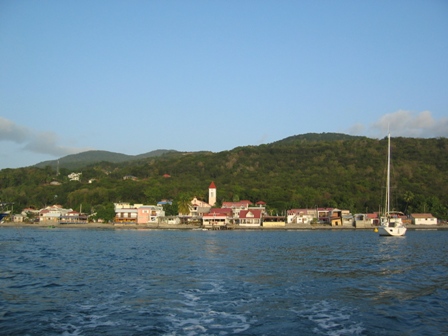
The town of Deshaies, a small fishing village.
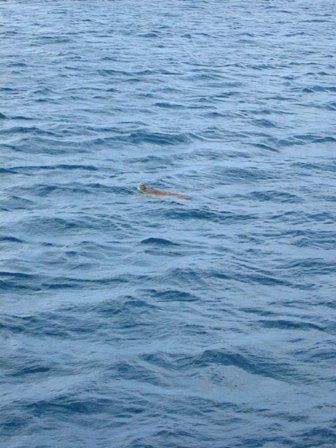
A Green Sea Turtle coming up next to our boat to get some air!!!
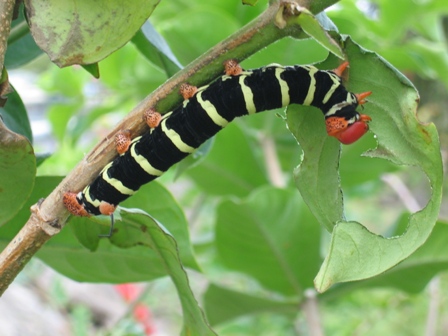
One of the many local insects.
We relaxed here, Harry and Judith had us over for dinner and after clearing out of customs left early the next morning for Antigua where we will meet back up with Cinnabar, Durrus and Barbaro. Many more fun times ahead.